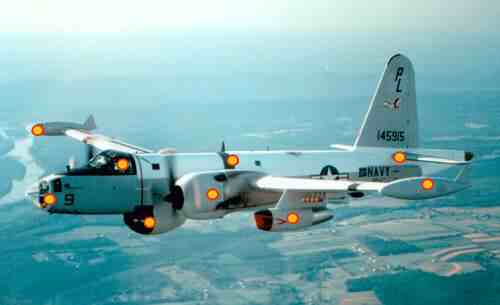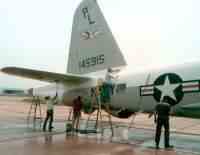
The 'Truculent Turtle"
In late September 1946 a new milestone in aviation history was set, an 11,236-mile non-stop, non-refueled flight from Perth, Australia to Columbus, Ohio. The plane, a US Navy Neptune patrol aircraft, manufactured by Lockheed and nicknamed "Truculent Turtle," was specially fitted with extra gasoline tanks to test its capacity for long-distance flight.
The crew of four made the trip in 55 hours and 17 minutes, at an average speed of 204 mph. Their only passenger was a young kangaroo named Joey, a gift from the Australian people to the National Zoo in Washington.
The Turtle's record held for nearly 15 years, though a New York Times editor opined that the flight's significance had "no practicable application ... to commercial transport of passengers" unless such a flight could ever be accomplished at much higher speeds, with far less time spent in the air.
In the 1950s, the Turtle was put on display at the corner of Granby Street and Taussig Boulevard, where it remained a landmark for many years, until the construction of I-564 in 1967 necessitated its removal to the interior of the Naval Air Station. In 1977, the little plane was transported to a new home at the National Museum of Naval Aviation in Pensacola, Florida.
[click to close]

The Lockheed P2V "Neptune" is unique in that it is the only American naval land-based patrol plane ever designed expressly for this purpose. Both the Neptune's predecessor, the PV2 "Harpoon", and successor, the P3 "Orion", were first built by Lockheed as transports... the PV2 as the "Lodestar", and the P3 as the "Electra". The P2V was also the last US military aircraft to feature the Emerson ball turret, which was installed for a time in the aircraft nose, and was the last radial engine powered bomber accepted for delivery by the US. From May 12, 1945 to the end of its production run in 1962, 1,036 Neptune's were produced in seven major variants, with the US Navy receiving the vast majority. The Neptune's versatility is evident from the many missions this aircraft was called on to perform... it truly set the standard for modern patrol aircraft.
In early 1941, Lockheed Aircraft's Vega division began design work on a twin-engined bomber. It was felt that the aircraft, utilizing the then new Wright R-3350 Cyclone engine, would be able to carry a larger bomb load for longer distances than existing four engined heavy bombers like the B-17 "Flying Fortress" and B-24 "Liberator". The resulting aircraft design, designated "model 26", was a large, mid-wing bomber, accommodating a crew of seven. Because it was a relatively low wartime priority, (at the time even longer range and heavier bomb loads were being planned for), the "model 26" project's R-3350 engines were diverted to another project, the Boeing B-29 "Superfortress". Development of the "model 26" prototype was renewed as the war progressed, however, with fifteen aircraft ordered by the Navy in April of 1944. The XP2V-1 "Neptune", as it was designated, was finally flown for the first time toward the end of the war on May 17, 1945, shortly after the German surrender.
As with many of the aircraft with a relatively long production run, the original P2 design saw a great many changes from model to model. Successive "Neptune" models gradually removed armament in favor of more anti-submarine electronics, but all models kept the large weapons bay included in the design of the first "Neptune" model, the P2V-1. In additional armament, the P2V-1 carried three pairs of 12.7 mm machine guns and mountings for up to sixteen underwing rockets.
The P2V-2 model added up to eight 20mm cannons in the nose, tail, and dorsal position. The P2V-3 began the trend of eliminating armament in place of more electronics, by adding APS-20 radar and the characteristic belly radome. The P2V-4 introded the turbo-compound engine and auxiliary wingtip fuel tanks. Increasing weight (Including the addition of Jezebel underwater detection equipment) caused many of the P2V-5 models to include the retrofit of Westinghouse J 34 jets to improve takeoff, and to add maneuvering speed during combat. (This model was designated the P2V-5F). The addition of the MAD stinger, first on the P2V-5, and the deletion of guns and the top turret, as the subs went nuclear, brought the Neptune to its final major configuration, the P2V-7, which was flown first on April 26, 1954. This last model was to remain in service for more than 20 years. P2V "Neptunes" were operated by the US Navy, Army and Air Force, as well as Argentina, Australia, Brazil, France, the Netherlands, Portugal, and the United Kingdom. In addition, the Japanese defense force utilized the design, produced under license by Kawasaki, with turboprop powerplants.
Assuming its patrol duties with the US Navy shortly after the Second World War, Neptunes saw their first combat use during the Korean Conflict. There they were used in ground attack, mine laying, day and night bombing and rocket attack and as armored combat transports as well. They became the "Cold War" patrol aircraft along both American coasts, were active in the Cuban missile crisis, and participated in the American space program as well. During the Viet Nam war P2's were involved with electronic warfare and, as night and all-weather interdiction aircraft. (The Army's OP-2E version dropped sensors along the Ho Chi Minh trail and other supply routes to detect enemy troop and vehicle movement.)
 The
most famous "Neptune" was, without a doubt, a P2V-1, the
"Truculent
Turtle", which, from September 29th through October 1st, 1947, flew non-stop,
without refueling, from Perth, Australia, to Columbus, Ohio, a world-record
setting distance of 11,235 miles. This piston engine powered record stood almost
forty years, until Burt
Rutan's "Voyager"
circled the globe non-stop in December of 1986. A more typical "Neptune" mission
lasted ten hours, with a crew of ten. Because of the long mission capabilities,
the P2's were equipped with a small galley and an electric stove. The only bunk,
however, was soon removed to make way for additional electronics gear, with
the floor or wing being the only place to stretch out.
The
most famous "Neptune" was, without a doubt, a P2V-1, the
"Truculent
Turtle", which, from September 29th through October 1st, 1947, flew non-stop,
without refueling, from Perth, Australia, to Columbus, Ohio, a world-record
setting distance of 11,235 miles. This piston engine powered record stood almost
forty years, until Burt
Rutan's "Voyager"
circled the globe non-stop in December of 1986. A more typical "Neptune" mission
lasted ten hours, with a crew of ten. Because of the long mission capabilities,
the P2's were equipped with a small galley and an electric stove. The only bunk,
however, was soon removed to make way for additional electronics gear, with
the floor or wing being the only place to stretch out.
Despite the Neptune's long service history, and significant role in aviation and in our nation's defense, very few of these unique aircraft have been preserved in museums. The Naval Museum in Pensacola does have on display both the "Truculent Turtle" and a P2V-7 model as well. A P2V-5 is on the deck of the Intrepid Air and Space Museum in New York, and an AP2H exists on display at the Pima Air Museum in Tucson. A few more remain as gate guardians at Naval Air Stations, including NAS Brunswick, and NAS Jacksonville.
Operational Neptunes are even more difficult to find. Several have found service as fire bombers in the western United States. At this time, restored operating examples can also be found in the Netherlands and in Australia. In the United States, a few other P2V-7's have been operated for a time by museums, but not consistently. The Mid Atlantic Air Museum, of Reading, Pennsylvania, has operated its P2V-7, flying to airshows to display the aircraft, for more than ten years. The aircraft is an "ongoing restoration", each year becoming more authentic with the addition of new equipment.
 The
Mid Atlantic Air Museum acquired two P2V's through the Federal Surplus Property
program during the fall of 1983. BU NO 145915 filled the following assignments
during its time with the US Navy: VP 21 and VP-23, NAS Brunswick, VP-92 NAS
South Weymouth, VP-94 NAS New Orleans, VP-56 NAS Norfolk, and VP-67 NAS Memphis.
It served actively during the Cuban missile crisis in 1962, with VP-23.
The
Mid Atlantic Air Museum acquired two P2V's through the Federal Surplus Property
program during the fall of 1983. BU NO 145915 filled the following assignments
during its time with the US Navy: VP 21 and VP-23, NAS Brunswick, VP-92 NAS
South Weymouth, VP-94 NAS New Orleans, VP-56 NAS Norfolk, and VP-67 NAS Memphis.
It served actively during the Cuban missile crisis in 1962, with VP-23.

The Museum's Neptune restoration is now complete with sonobuoy, radar and electronic equipment, operational bomb bay and searchlight. In 1985 the Experimental Aircraft Association Convention at Oshkosh, Wisconsin the Museum's BUNO 145915 was awarded the best restored bomber title.
Friend Site:Warbird Alley
SPECIFICATIONS
Engines:
Two Curtiss-Wright R-3350-32WA
(3750 HP)
Two Westinghouse J-34-WE-36
turbojets (3400 Lbs static thrust)
Wing
Span: 103
Feet, 10 Inches
Length: 91
Feet, 8 Inches
Maximum Speed: 364
MPH
Range: 4,350
Miles
Armament: Up
to 12,000 Lbs. of bombs, torpedoes, depth charges, mines, or rockets.
| disclaimer | |
|
page modified |
|
|